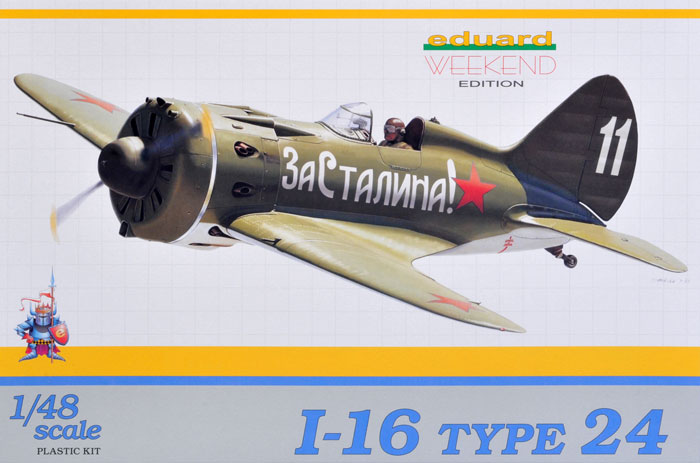|
Polikarpov I-16 Type 24
Weekend Edition

Eduard, 1/48 scale
S
u m m a r y |
| Catalogue Number: |
Eduard Kit No. 8468 - I-16 Type 24 Weekend Edition |
| Scale: |
1/48 |
| Contents and Media: |
94 sand coloured plastic parts on four sprues; 2 clear injection moulded plastic part on one sprue; A5 sized instruction booklet; parts plan; one page for paint and markings instructions. |
| Price: |
USD$19.95 available online from Eduard
and hobby retailers worldwide |
| Review Type: |
FirstLook |
| Advantages: |
Accurate outline, simple parts breakdown for easy construction, lovely detail, decals with thin carrier film and perfect register. |
| Disadvantages: |
Only one set of markings and no history notes |
| Conclusion: |
Full marks to Eduard for producing a decent I-16 in 1:48 scale. |
Reviewed by
Simon Wolff

Eduard's 1/48 I-16 Type 24 Weekend Edition is available online from Squadron.com
The I-16 was the first single seat low wing cantilever monoplane fighter to have retractable undercarriage. It entered service in 1934, and was also famous as a type used by the Republican Forces during the Spanish Civil War (nicknamed by the Spanish as ‘Rata’), fighting against such German fighters in service with the Nationalist forces as the Heinkel 51, which apparently it was superior to.
From the start of it’s entry in to service with the Soviets in 1934 the I-16 was progressively improved upon over a number of years. Each subsequent type was designated by a number.
The Type 24 differed from early types in having a tail wheel, second cockpit door on the right hand side, landing flaps replaced drooping ailerons, a stiffened wing and improved power plant in the Shvetsov M-63. Armament was four ShKAS 6.62mm guns. Production ran to 934 aircraft.
The I-16 was the most numerous Soviet fighter type in service at the time of the German attack in 1941, apparently still in service until 1943.
The kit comes packaged in a sturdy cardboard box with a rather large and attractive box art illustration, which I can’t decide if it is a photo or illustration as it is so convincing. The parts are quite well moulded with only slight mould lines around some, but these look quite manageable and easy to clean up.
This aircraft takes me back to the rather ancient Revel 1:72 kit which must date from the 1960’s, a rather dreadfully inaccurate kit but the level of detail crammed in to such a small kit for ‘those days’ with separate fuselage panel was to a small boy a quite beautiful model but that canopy was so small and fiddly!
Although this is a small (lets say stubby) kit a careful study of the instructions is highly recommended, for example two types of exhausts stubs are supplied. One type straight and the other type curved, the model uses both and there are lots of them supplied although I could only find in the instructions positioning for ten of them (or may be I just need new glasses). There are also some unused parts such as another propeller, spinners, undercarriage doors, tailskid and cowling. One frustrating thing I find with this instruction sheet is they show the fuselage halves assembly illustrated upside down on one page then right way up the next - which I personally found distracting.
The surface detail is quite refined and beautifully done, detail such as that on the tailplanes, rudder and wing surface simulated ribbing is lovely.
Interior detail consists of six parts attaching to the inner fuselage sides along with five for the pilots seat and floor. For the consul/dashboard you have the option of using a decal on a smooth part or another part this time with raised surface detail. The cockpit opening is fairly narrow so I am not sure how much will show up once you fix the small canopy in place… but I guess you the builder will know it’s there!
The wing to fuselage assembly is standard with two top wing halves joining a one piece lower part and fitting to the fuselage.
Engine detail is very basic consisting of a disc with slightly moulded raised cylinders; however there is good reason for making it basic in that you won’t see much if any of it behind the cowling with its nine small slots set in the front of the cowling.
When it comes to the undercarriage this looks to be a bit more involved due to the more complex structure with a number of undercarriage doors parts and slender legs and braces. Fortunately the instructions cover this area thoroughly with some seven illustrations. A dry run would be advisable here.
Marking Options
Markings are provided for one aircraft piloted by Boris F. Safanov, 72.SAP, Northern Fleet, 1941. His aircraft had large patriotic writing on each side of the fuselage (which at a blink looks like ‘3A Tasmania’). The patriotic inscriptions have a large piece of film around them, my concern being will this show up once applied to the kit as trimming back could be difficult – just a thought.

I can’t vouch for the absoloute accuracy of this kit but looking at photos of the flying examples it certainly looks correct in shape and detail.
Edaurd's 1/48 scale I-16 Type 24 is a delightful looking kit which should go together quite comfortably.
Thanks to Eduard for the sample
Review Text Copyright © 2009 by Simon Wolff
Page Created 1 April, 2009
Last updated
1 April, 2009
Back to HyperScale Main Page
Back to Reviews Page |
